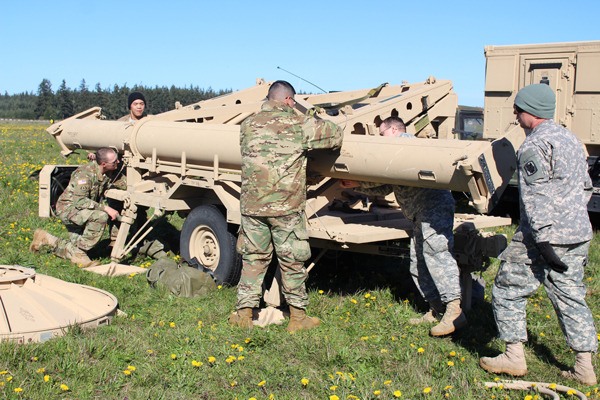The Army paid a visit to Coupeville’s Outlying Field this week to practice skills that could save lives here someday.
The Army’s 51st Signal Battalion (Expeditionary) is focused on military communications but they also train to assist civilian agencies during natural disasters such as the massive earthquake expected in the Northwest’s future.
They traveled to Whidbey Island with a troposcatter communications system, which includes two large pieces of equipment that resemble Mickey Mouse ears. The system transmits and receives microwave radio signals by bouncing them off layers of the Earth’s atmosphere.
“We’re completely self-sustaining,” said Capt. Frank Guizar, company commander. “We’re able to move quickly anytime for disaster relief.”
This week’s exercise was focused on humanitarian relief, with personnel at Joint Base Lewis-McChord set up to receive transmissions, he said.
The battalion’s Charley Company set up tents and operated 24-7 from the Coupeville air field.
The military has used troposcatter communications since the 1960s to transmit voice and data without satellites or high-frequency radio signals.
Troposcatter communications are more secure because their radio waves are difficult for enemies to intercept.
With limited satellites available, using the technology makes sense, said Lt. Col. Mike Kaloostian.
In a natural disaster, the Army could provide a communications network when telephone lines and internet are down.
The Army is testing new systems that would allow civilians who use “dirty Internet” — basically Gmail and the like — to access them in an emergency with military equipment.
The troposcatter equipment is the most difficult piece of technology to set up in the field that the signal corps uses, he said. It’s rugged enough to work in the mountains of South Korea, but its operators need to practice using it under different geographic settings.
The unit already has practiced in desert and mountain scenarios. The Outlying Field provided practice sending signals over water.
Sailors from NAS Whidbey’s Maritime Patrol and Reconnaissance Wing 10’s Mobile Tactical Operations Center 12 trained some of the time with the Army. They use similar mobile systems deployed overseas.
The company commander emphasized the importance of working together effectively with the Navy.
“We’re here to work together, tie into each other and support one another in order to accomplish the overall mission of taking care of the American people,” Guizar said.



